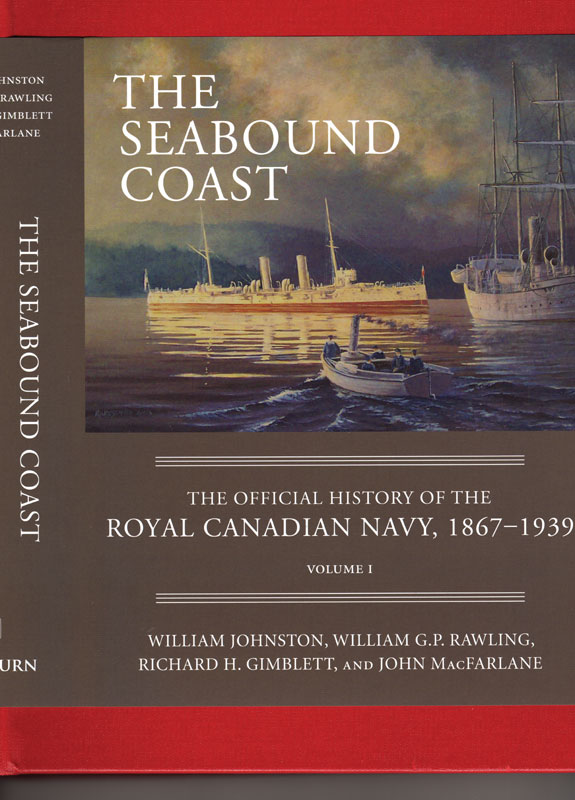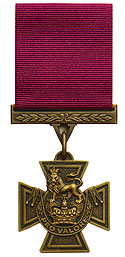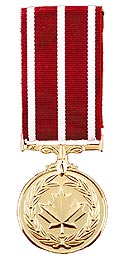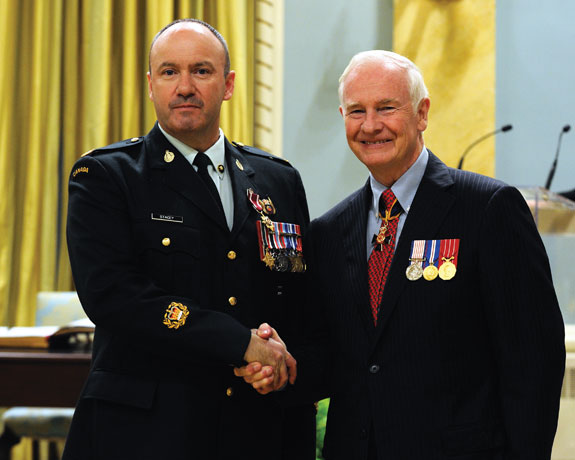Main Heading of Page (h1)
 This information has been archived for reference or research purposes.
This information has been archived for reference or research purposes.
Archived Content
Information identified as archived on the Web is for reference, research or recordkeeping purposes. It has not been altered or updated after the date of archiving. Web pages that are archived on the Web are not subject to the Government of Canada Web Standards. As per the Communications Policy of the Government of Canada, you can request alternate formats on the "Contact Us" page.
Valour (Vol. 11, No. 4)
Book Reviews

The Seabound Coast: The Official History of the Royal Canadian Navy, 1867-1939, Vol. I
By William Johnston, William G.P. Rawling, Richard H.Gimblett, and John MacFarlane
Toronto: Dundurn Press, 2010
1014 pages, $70.00
ISBN: 978-1-55488-907-5
For more information on accessing this file, please visit our help page.
When I first picked up this book, there were a couple of things that immediately struck me, and they caused me to wonder if this book was really about the Royal Canadian Navy (RCN). The first was the sheer the size of the volume at over 1000 pages; the second was the image on the back cover, which makes one think of some sea battle off the Dutch coast; and the third was the start date of 1867 for the defined scope of the work, over 40 years before the founding of the Canadian Navy. Nevertheless, all is explained in the first few pages.
Although the book is substantial in length, it is very well researched and very readable, with chapters being well defined. This allows the reader to fully appreciate a very colourful and exciting time in Canada, namely, the development of a national navy.
The book starts its narrative well before 1867, through an accounting of Canada's maritime history with the arrival of the Europeans, and the centuries-long conflict between France and Britain. Hence, the image chosen for the back cover. Although the British conquest and final victory in North America is perhaps best remembered by the battle on the Plains of Abraham, the authors clearly establish that the British operations against the French very much constituted both a sea and a land campaign.
The next threat to Canada would come from the south during the War of 1812. Although most Canadians are well aware of the battles at Lundy's Lane and Queenston Heights, the sea battles for control of the Lake Ontario and Lake Erie are less well known. However, the authors do a credible job of describing that era.
The first chapter of the book begins with Confederation and the question of naval defence. As the writers remind us, it is the United States that generates the greatest security concerns. The Americans, having just come through a civil war, were pushing their settlers west, and this raised the chilling spectre of Manifest Destiny, especially considering the state of Canada's invitingly-empty western territories. Because the threat was continental, as opposed to maritime, it was clear that Canada's defence rested upon Britain being able to transport troops to Canada if a threat from the south seriously materialized. Therefore, it was important that Britain retain its two continental naval stations, one in Halifax, and the other in Esquimalt, British Columbia. However, as the book points out, as time went on, Canada came to realize that Britain was also keenly interested in keeping peace with the United States, and was sometimes doing so at Canada's expense. The fisheries situation pertaining to the east coast, and the Alaskan boundary disputes, are two cited examples of this trend.
By the turn of the 19th Century, the situation was starting to change. The threat for Britain no longer came from the United States, but from Germany. The launching of HMS Dreadnaught had rendered obsolete every warship that had preceded it, and consequently, Britain's huge numerical advantage of warships over her naval rivals was greatly reduced. Britain clearly suffered from ‘Imperial overstretch,’ and was desperately searching for a remedy. The Admiralty's preferred solution was to require Britain's colonies to pay for their defence by creating an ‘Imperial fleet’ through contributions toward the building of British warships. Canada’s Prime Minister Laurier, however, had a different plan, and he had built a consensus across the population, including (importantly) Quebec, for an independent Canadian Naval Service as a much more palatable alternative. As a result, on 4 May 1910, the Canadian Navy came into being. However, as the authors point out, the election the following year of Robert Borden as Prime Minister, who had campaigned against the establishment of the navy, created a great amount of uncertainty, not only in Canada, but in Britain, with respect to Canadian intentions. In fact, in hope of getting at least something out of the Canadians, the British Admiralty dispatched Admiral Jellicoe with the suggestion that perhaps Canadian shipyards could be put to work building submarines. However, as the authors point out, when Canada entered the war, it had contributed neither submarines nor dreadnaughts to the imperial fleet, nor had it yet formed a proper naval service.
Canada's contribution to the First World War was four army divisions for the battlefields of France and Belgium, but no resources were provided for the navy to defend Canada's coasts. This omission became all too apparent when German submarines started operating in Canadian waters. The writers have also added an interesting section dealing with Canada's vulnerability to a surface threat, when the German cruiser Leipzig appeared off the West Coast. Then, the relatively-familiar story of the provincially-owned British Columbia submarines adds some new information, and also makes for an amusing read. Not so amusing, of course, was the navy's lack of success against German submarines, which seemed to be operating at will as far west as the Gulf of St. Lawrence. This created a great amount of angst; indeed, panic, and quite naturally, blame was directed at the navy. Finally, when it seemed that the navy's reputation could not sink much lower, on 6 December 1917, in Halifax harbour, the Norwegian-registered ship Imo, (although also confusingly referred to in the book as being of both Belgian and Norwegian registry) collided with the French ammunition ship Mont Blanc. The resulting explosion killed 1600 people, injured another 9000, mostly from flying glass, and rendered 6000 Haligonians homeless. Although the navy was a hapless bystander, an anxious and angry populace looked for someone to blame, and the navy became a convenient target. The only positive result that came out of this tragedy was that the responsibility for shipping was passed to the British Ministry of Shipping, and this allowed the navy to return its focus upon defending Canada's coasts. When the First World War ended, it was the army that had defined the nation, and the navy turned out to be more of an overall embarrassment. Consequently, the cuts to an already-underfunded institution came quickly, and by 1922, the navy was down to two ships, and a personnel establishment of 80 officers and 250 ratings. However, as the authors point out, the navy had at its helm Commodore Walter Hose, whose seemingly-unending optimism knew no bounds. Hose wrote, in 1922, that within a couple of years, he would have 1500 men organized and trained, and that the naval service would again expand into a seagoing service. as it materialized, he was right.
The final chapters of the book detail the efforts of men like Hose and Nelles, who would keep the navy alive. In fact, so much so, that in 1939, the Royal Canadian Navy entered the war as a more coherent force with a much better understanding of its mission. The work completed by Hose would lay the foundation for a navy that ‘punched well above its weight’ in the next conflict.
The book contains a large number of photographs, maps, and diagrams, which add greatly to its credibility and impact. In sum, The Seabound Coast fills a long standing gap in the history of Canada and her Maritime roots, and it is essential reading for the serious historian.
Lieutenant-Commander Jurgen Duewel, CD, is a Maritime Surface Officer, on staff at the Canadian Defence Academy in Kingston. He holds a Master of Arts Degree in War Studies from RMC, and is presently working on a doctorate in Educational Leadership.
DND photo GG0318-049 by Master Corporal Dany Veillette
Group shot of the recipients at the 10 June presentation ceremony held at Rideau Hall.
For more information on accessing this file, please visit our help page.
Canada’s three military valour decorations, namely, the Victoria Cross, the Star of Military Valour, and the Medal of Military Valour, were created by Her Majesty Queen Elizabeth II, Queen of Canada, on 1 January 1993. All the decorations may be awarded posthumously.
The Victoria Cross is awarded for the most conspicuous bravery, a daring or pre-eminent act of valour or self-sacrifice, or extreme devotion to duty in the presence of the enemy.
The Star of Military Valour is awarded for distinguished or valiant service in the presence of the enemy.
The Medal of Military Valour is awarded for an act of valour or devotion to duty in the presence of the enemy.
Additionally, the Mention in Dispatches was created to recognize members of the Canadian Forces on active service and other individuals working with or in conjunction with the Canadian Forces for valiant conduct, devotion to duty, or other distinguished service. Recipients are entitled to wear a bronze oak leaf on the appropriate campaign or service medal ribbon. Like the military valour decorations, the Mention in Dispatches may be awarded posthumously.

Victoria Cross |

Star of Military Valour |

Medal of Military Valour |
On 10 June 2011, His Excellency the Right Honourable David Johnston, Governor General and Commander-in-Chief of Canada, awarded two Stars of Military Valour and six Medals of Military Valour, as well as 38 Meritorious Service Decorations, to members of the Canadian Forces and allied forces.
These members received their decorations during a ceremony held at Rideau Hall in the presence of the Chief of the Defence Staff. They were recognized for devotion and acts of valour in the presence of the enemy, and for military deeds performed in a highly professional manner. During the ceremony, Governor General Johnston said, in part:
It is with great pride and respect that I welcome you to Rideau Hall today.
This ceremony is an opportunity to recognize your outstanding dedication to the principles that make this country great. Your commitment to serving others and to the basic rights and freedoms we enjoy in Canada is truly an example to us all.
Allow me to quote my predecessor, General Georges Vanier, who once said: “The overpowering strength of a free people is the readiness voluntarily to defend not merely themselves, not only their allies, but the very democratic principles they cherish.”
When you enlisted in the Canadian Forces, each of you demonstrated that readiness. And today, each of you is here because you have lived up to your ideals and served these principles in an extraordinary manner…
Canadians have a lengthy tradition of service and of sacrifice for our ideals. Ninety-seven years ago, at the outset of the First World War, Prime Minister Robert Borden spoke of the “… fortitude, the determination and the resourcefulness” that would carry our nation through that terrible conflict.
The same can be said of your qualities as members of the present-day Canadian Forces. As a result, you have helped us to navigate new challenges in the 21st Century…
Today, as you receive your decorations for military valour and meritorious service, your responsibility is made even greater. You must never underestimate the power of your example as role models, because you embody the depth of our commitment to the common good.
These decorations are a testament to your courage, ingenuity and quiet determination, which have led you to fulfill your duty in remarkable ways. And so it is with great pleasure that I thank you for your efforts on behalf of all Canadians.
Your example of service and devotion is an inspiration to us all.
Thank you.
MILITARY VALOUR DECORATIONS
Star of Military Valour
Lieutenant Gabriel Chassé-Jean, SMV ~ Alma, Qu
Master Warrant Officer Richard Stacey, SMV, CD ~ Edmonton, Alta
Medal of Military Valour
Sergeant T. David Bérubé, MMV, CD ~ Québec, Que
Master Corporal Simon R. Frigon, MMV ~ Québec, Que
Master Corporal Jeremy Joseph James Leblanc, MMV ~ Coalhurst, Alta
Sergeant Joseph Martin Stéphane Mercier, MMV, CD ~ La Sarre, Que
Leading Seaman Pier-Vincent Michaud, MMV ~ Trois-Rivières, Que
Sergeant Joseph Denis François Ranger, MMV, CD ~ Vaudreuil, Que
CITATIONS
![Lieutenant [now Captain] Chassé-Jean receives his Star of Military Valour from His Excellency the Right Honourable David Johnston.](images/lieutenant_page3.jpg)
DND photo GG0318-001 by Master Corporal Dany Veillette
Lieutenant [now Captain] Chassé-Jean receives his Star of Military Valour from His Excellency the Right Honourable David Johnston.
Lieutenant Gabriel Chassé- Jean, SMV
Star of Military Valour
From June 8 to 29, 2009, Lieutenant Chassé-Jean demonstrated valiant service under fire while leading his platoon to defeat the enemy in Afghanistan. Over an extended period, and amidst the chaos and confusion of combat, his fearless conduct in the engagement of a determined enemy, as well as his ability to keep his soldiers composed, were critical to multiple victories in a difficult theatre of operation. Whether leading a frontal assault, controlling the situation while trapped in dangerous positions, or directing supporting gunfire, he showed courage and inspirational leadership, which were the key to the success of multiple engagements.

DND photo GG0318-002 by Master Corporal Dany Veillette
The Governor General presents the Star of Military Valour to Master Warrant Officer Stacey.
Master Warrant Officer Richard Stacey, SMV, CD
Star of Military Valour
On August 4, 2009, Master Warrant Officer Stacey’s valour in the face of the enemy enabled his multinational combat team to fight through multiple ambushes by insurgents in Afghanistan. He led the complex recovery of multiple vehicles which had been disabled by improvised explosive devices, while under enemy fire from all sides. He sorted through the chaos and issued clear direction to Canadian, American and Afghan forces. Throughout eight hours of intense combat, his gallantry, perseverance and selfless dedication to his soldiers were critical to defeating a ferocious and determined enemy.
Sergeant T. David Bérubé, MMV, CD
Medal of Military Valour
From May 29 to June 29, 2009, Sergeant Bérubé repeatedly placed himself in exposed positions to coordinate fire support for his combat team during operations in Afghanistan. Often isolated and finding himself in dangerous positions, he fearlessly moved forward to gain a clear view of the battlefield and guide artillery and aviation assets onto their targets. His ability to simultaneously and accurately coordinate multiple gun batteries and attack helicopters, while under intense enemy fire, was a decisive factor in the engagements. His courage and outstanding soldiering ability were crucial to the defeat of the enemy.
Master Corporal Simon R. Frigon, MMV
Medal of Military Valour
As a section commander in Afghanistan, Master Corporal Frigon distinguished himself during two separate enemy engagements on May 7 and 20, 2009. In both instances his section was trapped and isolated during an ambush. Yet his unwavering composure and willingness to expose himself to enemy fire inspired his soldiers and instilled them with confidence. With little regard for his personal safety, he was able to precisely define the enemy location, defeat the initial attack and lead his section’s fighting withdrawal. Master Corporal Frigon’s courageous front line leadership and tactical acumen were critical to repelling the enemy without taking casualties.
Master Corporal Jeremy Joseph James Leblanc, MMV
Medal of Military Valour
On October 14, 2006, Master Corporal Leblanc’s section was occupying a position in Afghanistan when insurgents unleashed a devastating attack that resulted in several casualties, including the death of his section commander. Seamlessly assuming command, he rallied his section to return fire while personally tending to the wounded. Despite being injured himself and under constant fire, he continued to lead and inspire his section to keep fighting and hold its ground against a determined enemy. His selfless actions no doubt saved the lives of some of his fellow soldiers.
Sergeant Joseph Martin Stéphane Mercier, MMV, CD
Medal of Military Valour
From April 28 to August 15, 2009, Sergeant Mercier displayed courage in the aftermath of several ambushes and improvised explosive device attacks in Afghanistan. Willing to expose himself to heavy fire, he often moved fearlessly throughout the battlefield to identify enemy locations, provide clear direction to his soldiers and position himself to effectively engage the enemy. Throughout these intense battles, his front line leadership, tactical acumen and unwavering courage inspired confidence in his soldiers, kept them safe and enabled them to repeatedly defeat a determined enemy.
Leading Seaman Pier-Vincent Michaud, MMV
Medal of Military Valour
On May 29, 2009, Leading Seaman Michaud was a member of a joint Canadian-Afghan patrol that was ambushed by the enemy, leaving one Afghan soldier dead and severely wounding two others . Immediately engaged in an intense, close-quarter firefight, Leading Seaman Michaud directed the Afghan soldiers to seek cover and then moved 50 metres to the casualties’ location, which provided a short 60-centimetre wall for cover. As bullets impacted all around his position, he calmly administered first aid to the casualties and personally brought them to the extraction zone, despite the unrelenting enemy attack. His courage and selfless actions undoubtedly saved the lives of the Afghan soldiers.
Sergeant Joseph Denis François Ranger, MMV, CD
Medal of Military Valour
On June 14, 2009, Sergeant Ranger was mentoring an Afghan reconnaissance company during an air-mobile operation when they were attacked by insurgents. With the company taking heavy mortar fire and suffering numerous casualties, Sergeant Ranger rallied his soldiers, established a position and returned heavy fire. As mortar bombs continued to fall, and with little regard for his personal safety, he single-handedly secured a casualty evacuation point. His leadership, fearless engagement of the enemy and ability to stay composed were critical to the defeat of the insurgents and the successful evacuation of casualties.






